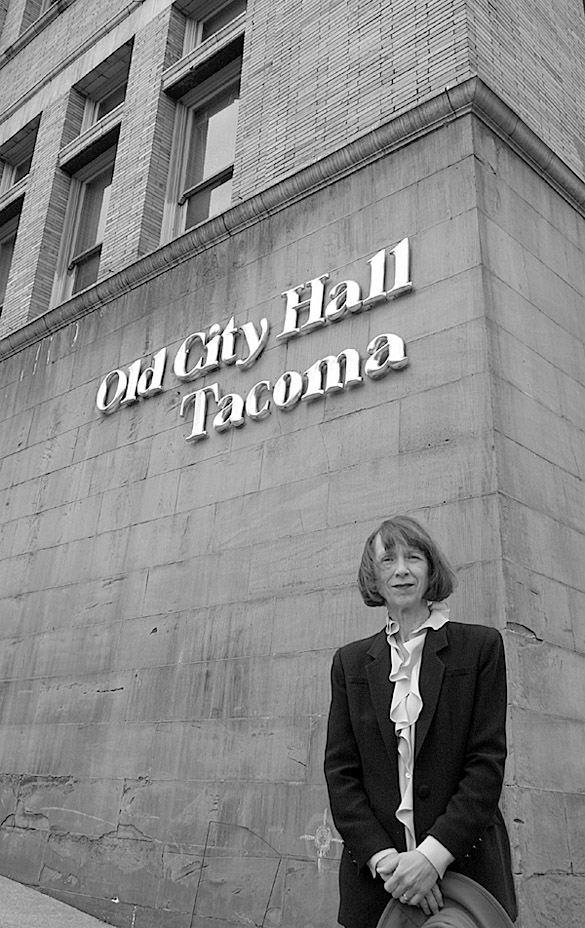EDITOR’S NOTE: This article originally appeared in the Tues., Nov. 21, 2006, edition of the Tacoma Daily Index. It was inadvertently lost when the Index upgraded its Web site in spring/summer 2012. It has been re-posted so it can be included in the Index’s online archives. –TM
WHEN TACOMA RESIDENT Sharon Winters looks at the city’s historically significant buildings, she grows concerned.
A wrecking ball’s shadow looms over First United Methodist Church — a 90-year-old building sold by the congregation to MultiCare Health System in May for $8 million. The church plans to move into new headquarters; the hospital wants to tear down the building and expand its campus; and preservationists have until Nov. 21 to file an appeal with Pierce County Superior Court.
The 80-year-old Mattson Mansion in the city’s north end was razed in a single afternoon last spring. The building, a staple of historic home tours, slipped through cracks in the city’s historic preservation list (though some 1,200 buildings comprise the list, the Mattson Mansion wasn’t one), will be replaced by a new 10,000-square-foot Craftsman-style home.
“The city is at a very vulnerable time right now,” explains Winters, former chair of the city’s Landmarks Preservation Commission, during a meeting earlier this month at a downtown coffee shop. “It’s a very exciting time for Tacoma, but also a very vulnerable time for the old structures in town.”
Enter Historic Tacoma — a grassroots organization formed this summer by Winters and fellow historians Michael Sullivan, Reuben McKnight, Morgan Alexander, and Eugenia Woo to address public policy concerns related to the city’s historic-style buildings. Winters, the group’s board president, is the public face of a renewed interest in the city’s history. In August, Historic Tacoma’s first public meeting drew 45 people to the Tacoma Public Library, the group’s board consists of well-connected Tacomans inside and outside City Hall, and it’s a focal point for a growing number of younger, Web-savvy Tacomans concerned about urban livability and historic preservation.
Historic advocacy groups aren’t new. Spokane Preservation Advocates has operated in its namesake city for nearly 10 years. Historic Seattle has preserved 45 buildings over its 32-year existence, and operates as a charitable foundation and public development authority. And 30-year-old Washington Trust for Historic Preservation is a statewide non-profit that safeguards historic places through education and advocacy efforts.
In Tacoma, however, preservation movements have centered on specific buildings and causes.
Albers Mill faced demolition at one point but was converted into apartments along Thea Foss Waterway after citizen uproar. Similarly, Union Station was nearly razed before Tacomans pushed for its adaptive reuse (today it is home to a federal courthouse and the Washington State History Museum). And the former Elk’s Lodge on Broadway, as well as Murray Morgan Bridge, avoided certain doom thanks to citizen activists.
Still, once buildings were saved, advocacy groups typically dissolved.
“I have always thought that Tacoma could really use an independent voice coming from its citizens,” says McKnight, the City’s historic preservation officer. McKnight is Historic Tacoma’s connection to City Hall (though he serves on Historic Tacoma’s board, he is a non-voting, ex officio member). “I thought that was something that was sort of missing. In previous times, people have tended to rally around certain projects and certain issues. Something like Albers Mill would get everybody out and waving the preservation flag, but there wasn’t any continuity to it. The groups would sort of fizzle away.”
An independent, sustainable advocacy group poised to lobby City Council and the Landmarks Preservation Commission on historic preservation policies is long overdue, say most local historians.
Winters sees Historic Tacoma as the vehicle for long-term and comprehensive action. “We are really concerned about sustainability of an effort,” she explains, “so that instead of being in this reactive position of saving a building, we can be more proactive.”
HISTORIC TACOMA REALLY took shape when Winters stepped down as chair of the city’s Landmarks Preservation Commission. Winters, a member of the commission for six years, departed after budget cuts shrank the sizes of city commissions. She was hardly burned out and, in fact, was really starting to delve into historic preservation issues. “There was this energy level, and the commission was rolling,” she says. “And then it was like, ‘you have to leave.'”
At the beginning of this year, Winters, McKnight, Sullivan, Alexander, and Woo started to seriously talk about forming an advocacy group untethered from the landmark commission’s quasi-judicial affiliation. They were concerned about policies surrounding demolition — particularly for historically significant buildings that weren’t on the city’s register of historic places and therefore unprotected. Mattson Mansion’s destruction this spring furthered their concerns.
From the outset, Winters and her colleagues knew Historic Tacoma would be different. Instead of interpreting and documenting the city’s history through museum exhibits, it would serve as an advocacy group for the city’s old buildings. Whereas a typical historical society might have a mailing list and bricks-and-mortar museum presence, Historic Tacoma would operate almost entirely on the Internet (though the group does host public meetings, and plans to have walking tours of historic districts), thanks to tech-savvy board members who shaped a Web site, online discussion forum, and advocacy alerts sent to Historic Tacoma supporters when issues arise.
And Historic Tacoma’s creation comes at a time when local history has experienced a resurgence of sorts. This summer, a group of citizens, developers, and local business leaders rallied around the 81-year-old, 12-story Winthrop Hotel. The goal? Transform the low-income, affordable housing high-rise into a four-star historic hotel. Tacoma Streetcar, a small organization headed up by Historic Tacoma board member Alexander, has pushed for the creation of a historic streetcar that would connect business districts (Tacoma City Council approved a resolution June 27 directing city staff to work with Pierce Transit, Sound Transit, neighborhood councils, and local business districts to study the feasibility of developing a streetcar system).
And last December, the 16-year-old Tacoma Historical Society opened its first interactive museum in a Broadway storefront downtown. The small, clean, sepia-colored 750-square-foot space showcases a rotating collection of Tacoma photographs, maps, and posters pulled from a storage warehouse on Cedar Street. It’s the only historic museum in the city dedicated solely to Tacoma’s history.
Tucked between antique stores, the historic Bostwick Building, and the Winthrop Hotel, a simple A-frame sign outside a Broadway storefront advertises Tacoma’s early history. Inside, society president Dale Wirsing, a retired reporter and editor at the Tacoma News Tribune, tallies the number of visitors on a wall calendar splayed across his desk. Each month, 100 people or more visit the museum to check out its exhibits; the latest, Building Tacoma, documents the city’s boom and bust growth between 1852 and 1915. Others stop by to inspect an old streetcar map on loan from Pierce County Councilmember Timothy Farrell.
When Historic Tacoma hosted its first public meeting this summer, Wirsing says the Tacoma Historical Society offered its blessing. Advocacy was something the society had supported all along, he says, but didn’t always have the resources or expertise to take it on full-time.
“They are a much better organization to do that than we are,” he says. “Some of our members had the same feeling all along, but they’re not necessarily young professionals who know how to make themselves heard. One of the things that is great about their organization is that they have people who know of creative ways to do that. That’s really a better vehicle. They’ll be the people who speak up at city council meetings, landmark commission meetings, and so on. And we’ll be the people who say, ‘Amen.’
Historic Tacoma board member Michael Sullivan says both groups bring different, yet equally important, entry points to Tacoma History. Whereas Tacoma Historical Society is focused on research, writing, and its interpretive center, Historic Tacoma is more of an urban activist group. And, Sullivan adds, local interest is strong. The two groups hardly compete for membership and attention. “We’re already collaborating,” says Sullivan. “I think it’s just a sign of an emerging conscience in the city that is just growing. A lot of people will be active in both organizations.”
SOME OF THAT cooperation is also evident inside City Hall. Winters says she has heard from councilmembers and landmarks commission members pleased to see an advocacy group form. It’s easier for an outside group to voice its preferences than, say, a landmarks commission member who might become so politicized as to be recused.
Currently, Historic Tacoma wants to affect policy in a way that respects the value of historic architecture.
One idea: change city policy specifically tied to demolition of old buildings by establishing an ordinance that would create a default review period for buildings older than 50 years before demolition is permitted. “It’s something a lot of cities have on their books that we don’t,” she says.
Another idea: create a public development authority charged with historic preservation of surplus city property. A PDA would work with developers on the purchase and sale of an old building for adaptive reuse and historic preservation.
“When a city wants to surplus a building, there’s no sensitivity to putting that out to bid with language that gives advantage or consideration to people who would restore the structure,” says Winters. “I think that’s where we see opportunities to make connections throughout City Hall and Public Works — to raise awareness and sensitivity to Tacoma’s built environment.
“We want to come up with a solution that works for the city,” she adds, “but we also feel we need to make a good bit of movement on public policy.”
She points to a study released recently by the Washington State Department of Archaeology and Historic Preservation that outlines economic benefits of historic preservation. In Pierce County between 2000 and 2004, historic rehabilitation activities generated total sales of $28.7 million, supported 325 jobs, and d $11.1 million in wages and salaries.
So far, Historic Tacoma has met with the City’s community and economic development department, as well as Councilmember Jake Fey to open a discussion.
“It’s the environmental sustainability, it’s the built environment, it’s the urban livability that we are interested in,” she adds. “I think the aesthetic these buildings bring to the city is an important thing.”
It’s still early, but Historic Tacoma seems poised to achieve many of its goals. A growing interest in historic preservation is strong. Tacoma history, it seems, is very much alive.
“A lot of people have moved to Tacoma in the last couple years, and they see a real tangible sense of history,” explains McKnight. “People coming from a city larger than Tacoma find there’s a real opportunity to come involved that they might not have elsewhere.”
More information about Historic Tacoma is available online at historictacoma.org.
More information about the Tacoma Historical Society is available online at tacomahistory.org.
A copy of the Washington State Department of Archaeology and Historic Preservation’s report documenting economic benefits of historic preservation is available online here.


Todd Matthews is editor of the Tacoma Daily Index and recipient of an award for Outstanding Achievement in Media from the Washington State Department of Archaeology and Historic Preservation for his work covering historic preservation in Tacoma and Pierce County. He has earned four awards from the Society of Professional Journalists, including first-place honors for his feature article about Seattle’s bike messengers; second-place honors for his feature article about whistle-blowers in Washington State; third-place honors for his feature article about the University of Washington’s Innocence Project; and third-place honors for his feature interview with Prison Legal News founder Paul Wright. His work has appeared in All About Jazz, City Arts Tacoma, Earshot Jazz, Homeland Security Today, Jazz Steps, Journal of the San Juans, Lynnwood-Mountlake Terrace Enterprise, Prison Legal News, Rain Taxi, Real Change, Seattle Business Monthly, Seattle magazine, Tablet, Washington CEO, Washington Law & Politics, and Washington Free Press. He is a graduate of the University of Washington and holds a bachelor’s degree in communications. His journalism is collected online at wahmee.com.








